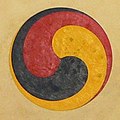Taegeuk: Difference between revisions
m remove Erik9bot category,outdated, tag and general fixes |
No edit summary |
||
| Line 19: | Line 19: | ||
In the film [[Attack the Gas Station|''Attack the Gas Station!'']], a character argues that [[Pepsi]] is a Korean product because it bears a logo similar to the ''Taegeuk''. |
In the film [[Attack the Gas Station|''Attack the Gas Station!'']], a character argues that [[Pepsi]] is a Korean product because it bears a logo similar to the ''Taegeuk''. |
||
===Paralympic usage=== |
|||
[[Image:Paralympics logo 1988-94.svg|150px|thumb|First Paralympic symbol (1988-1994) used five Tae-Geuks.]] |
|||
[[Image:IPC logo (1994-2004).svg|150px|thumb|Second Paralympic symbol (1994-2004) used three Tae-Geuks.]] |
|||
Prior to the end of the [[2004 Summer Paralympics]], the [[International Paralympic Committee]] used three Tae-Geuks in its logo. It was replaced with three [[Agito (symbol)|Agitos]]. The usage started at the [[1988 Summer Paralympics]] in [[Seoul]], using five Tae-Geuk designs arranged similarly to the [[Olympic Rings]], with a similar five color set. |
Prior to the end of the [[2004 Summer Paralympics]], the [[International Paralympic Committee]] used three Tae-Geuks in its logo. It was replaced with three [[Agito (symbol)|Agitos]]. The usage started at the [[1988 Summer Paralympics]] in [[Seoul]], using five Tae-Geuk designs arranged similarly to the [[Olympic Rings]], with a similar five color set. |
||
Revision as of 14:09, 21 March 2010
| Taegeuk | |
| Hangul | 태극 |
|---|---|
| Hanja | 太極 |
| Revised Romanization | Taegeuk |
| McCune–Reischauer | T'aegŭk |



Taegeuk is the Korean cognate of Taiji, the Taoist concept of yin and yang, from which all is actualized. In South Korea, the Taegeuk symbol is typically portrayed in blue (eum, or earth) and red (yang, or heaven). The red and blue are portrayed upside down to accommodate the harmony of nature. The blue (eum) on the flag is intended to pair up with the actual heaven (yang) and create a harmony with red, which would pair up with the actual earth (eum). An example would be have two magnets adjoining each other, "Taegeuk" symbol being in the middle. If the symbol is portrayed according to how humans view the world, red on the top would repel the earth and blue on the bottom would repel the heaven; this would break the harmony of nature.
The Taegeuk symbol is most prominently displayed on South Korea's national flag, called the Taegeukgi (along with four of the eight Palgwae diagrams). Because of the Taegeuk's association with the national flag, it is often used as a patriotic symbol, as are the colors red and blue.
A popular variant in Korea is the Sam-Taegeuk (三太極), which adds a yellow lobe, representing humanity, to the red and blue. The Sam-Taegeuk is frequently seen as a design on the face of fans.
Taegeuk (as well as palgwe) is also a series of Taekwondo forms practiced by Kukkiwon member instructors and their students; see Taeguk (Taekwondo).
In the film Attack the Gas Station!, a character argues that Pepsi is a Korean product because it bears a logo similar to the Taegeuk.
Paralympic usage


Prior to the end of the 2004 Summer Paralympics, the International Paralympic Committee used three Tae-Geuks in its logo. It was replaced with three Agitos. The usage started at the 1988 Summer Paralympics in Seoul, using five Tae-Geuk designs arranged similarly to the Olympic Rings, with a similar five color set.
See also